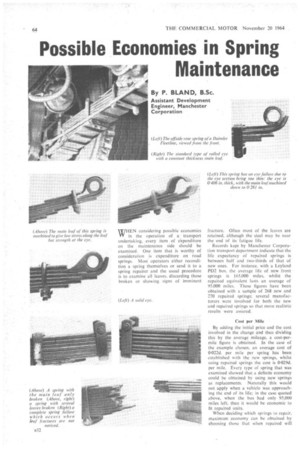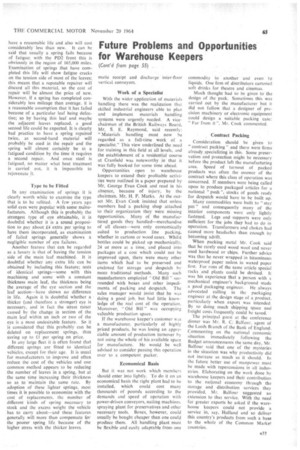Possible Economies in Spring Maintenance
Page 66

Page 67

If you've noticed an error in this article please click here to report it so we can fix it.
By P. BLAND, B.Sc.
Assistant Development Engineer, Manchester Corporation
WHEN considering possible economies in the operation of a. transport undertaking, every item of expenditure on the maintenance side should be examined. One item that is worthy of consideration is expenditure on road springs. Most operators either recondition a spring themselves or send it to a spring repairer and the usual procedure is to examine all leaves, discarding those broken or showing signs of imminent fracture. Often most of the leaves are retained, although the steel may be near the end Of its fatigue life.
Records kept by Manchester Corporation transport department indicate that the life expectancy of repaired springs is between half and two-thirds of that of new ones. For instance, with a Leyland Pll2 bus, the average life of new front springs is 165,000 miles, whilst the repaired equivalent lasts an average of 95,000 miles. These figures have been obtained with a sample of 268 new and 270 repaired springs; several manufacturers were involved for both the new and repaired springs so that more realistic results were assured.
Cost per Mile By adding the initial price and the cost involved in the change and then dividing this by the average mileage, a cost-permile figure is obtained. In the case of the example chosen, an average cost of 0.022d. per mile per spring has been established with the new springs, whilst using repaired springs the cost is 0.029d. per mile. Every type of spring that was examined showed that a definite economy could be obtained by using new springs as replacements. Naturally this would not apply when a vehicle was approaching the end of its life; in the ease quoted above, when the bus had only 95,000 miles left, then it would be economic to fit repaired units.
When deciding which springs to repair. maximum economy can be obtained by choosing those that when repaired will have a reasonable life and also will cost considerably lees than new. It can he said that usually a spring fails because of fatigue; with the PD2 front this is obviously in the region of 165,000 miles. Examination of springs that have completed this life will show fatigue cracks on the tension side of most of the leaves; this means that a reputable repairer will discard all this material, so the cost of repair will be almost the price of new. However, if a spring has completed considerably less mileage than average. it is a reasonable assumption that it has failed because of a particular leaf being defective; so by having this leaf and maybe the adjacent leaves replaced, a good second life could be expected. It is clearly bad practice to have a spring repaired twice, as second-hand material will probably be used in the repair and the spring will almost certainly be in a fatigued condition by the time it requires a second repair. And once steel is fatigued, no matter what heat treatment is carried out, it is impossible to rejuvenate it.
Type to be Fitted In any examination of springs it is clearly worth while to examine the type that is to be refitted. A few years ago solid eyes were popular with some mdnufacturers. Although this is probably the strongest type of eye obtainable, it is doubtful whether it is a sound proposition to pay about £4 extra per spring to have them incorporated, as examination of failed springs generally shows a negligible number of eye failures.
Another feature that can be regarded as a luxury is that of having the tension side of the main leaf machined. It is doubtful whether any extra life can be obtained by including this feature; tests of identical springs—some with this machining and some with a constant thickness main leaf, the thickness being the average of the eye section and the leaf section—have shown no difference in life. Again it is doubtful whether a thicker (and therefore a stronger) eye is necessary, and in fact the stress raiser caused by the change in section of the main leaf within an inch or two of the eye is a most undesirable feature. So it is considered that this probably can be deleted on replacement springs, thus saving up to £1 per spring on price.
In any large fleet it is often found that different springs are fitted to identical vehicles, except for their age. It is usual for manufacturers to improve and often reduce the cost of the vehicles and one common method appears to be reducing the number of leaves in a spring, but at the same time increasing their thickness so as to 'maintain the same rate. By adoption of these lighter springs, most times it is possible to economize with the cost of replacements the number of different kinds of spring necessary to stock and the excess weight the vehicle has to carry about—and these features generally will more than compensate for the poorer spring life because of the higher stress with the thicker leaves.




















































































































